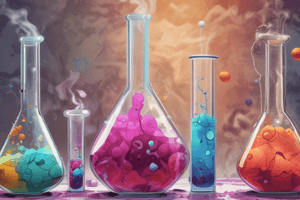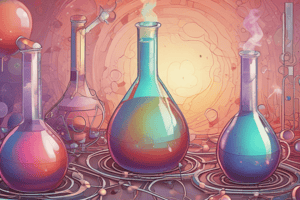Podcast
Questions and Answers
What is the primary characteristic of a chemical reaction?
What is the primary characteristic of a chemical reaction?
- Formation of a new substance (correct)
- Transfer of energy from one substance to another
- Decomposition of a single reactant
- Change in physical properties of a substance
What is the term for the rearrangement of atoms and molecules in reactants to form products?
What is the term for the rearrangement of atoms and molecules in reactants to form products?
- Atomic Rearrangement
- Chemical Model
- Law of Conservation of Mass (correct)
- Molecular Transformation
What type of reaction involves the release of energy as heat and light?
What type of reaction involves the release of energy as heat and light?
- Endothermic reaction
- Combustion reaction
- Thermal decomposition
- Exothermic reaction (correct)
What is the purpose of an indicator in a chemical reaction?
What is the purpose of an indicator in a chemical reaction?
What is the pH range of a neutral solution?
What is the pH range of a neutral solution?
Which of the following acids is a weak acid?
Which of the following acids is a weak acid?
What is the result of mixing an acid and an alkali?
What is the result of mixing an acid and an alkali?
What is the term for the energy stored in a fuel that can be released as heat?
What is the term for the energy stored in a fuel that can be released as heat?
What is the result of thermal decomposition?
What is the result of thermal decomposition?
What is the term for the reaction between a metal and an acid?
What is the term for the reaction between a metal and an acid?
Flashcards are hidden until you start studying
Study Notes
Chemical Reactions
- A chemical reaction involves a change in which a new substance is formed.
Reactants and Products
- Reactants are substances that react together, shown before the arrow in an equation.
- Products are substances formed in a chemical reaction, shown after the reaction arrow in an equation.
Chemical and Physical Changes
- Physical changes alter physical properties of a substance, but no new substance is formed.
- Chemical changes involve the rearrangement of atoms and molecules in reactants to form products, with the total number of atoms conserved (Law of Conservation of Mass).
Describing Chemical Reactions
- Word equations can be used to describe a chemical reaction.
Energy and Combustion
- Fuels store energy, which can be released as heat during combustion.
- Combustion is a reaction with oxygen, resulting in energy transfer to the surroundings as heat and light.
Types of Reactions
- Thermal decomposition: a single reactant breaks down into simpler products when heated.
- Exothermic reaction: energy is given out, usually as heat or light.
- Endothermic reaction: energy is taken in, usually as heat.
Acids and Alkalis
- Acids and alkalis can be corrosive or irritant and require safe handling.
- Indicators are used to identify whether unknown solutions are acidic or alkaline.
pH and Acid-Base Properties
- pH is a scale of acidity and alkalinity from 0 to 14.
- pH depends on acid strength: strong acids have lower pH values than weak acids.
- Acidic solutions have a pH below 7, neutral solutions have a pH of 7, and alkaline solutions have a pH above 7.
Examples of Acids
- Strong acids: hydrochloric, sulfuric, and nitric acid.
- Weak acids: acetic and citric acid.
Neutralisation
- Mixing an acid and alkali produces a chemical reaction, resulting in neutralisation.
Metals and Acids
- Some metals react with acids, forming a metal salt and hydrogen.
Studying That Suits You
Use AI to generate personalized quizzes and flashcards to suit your learning preferences.




